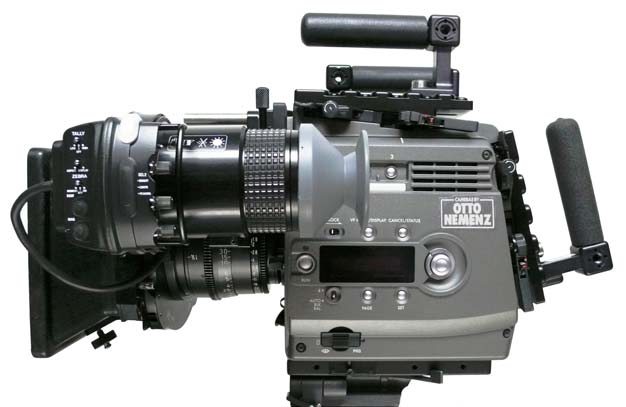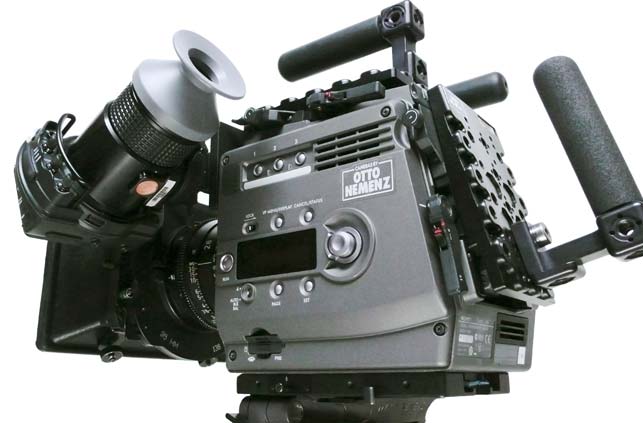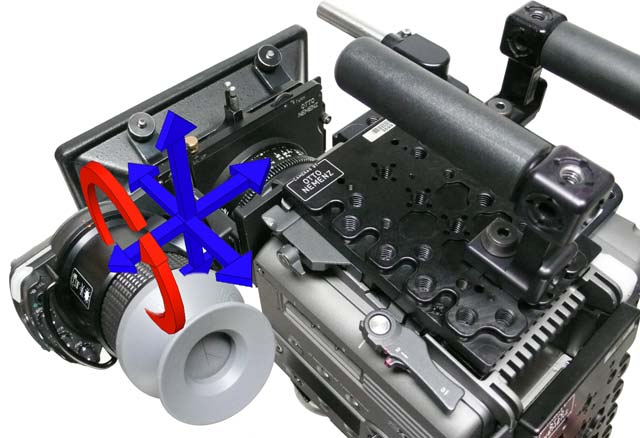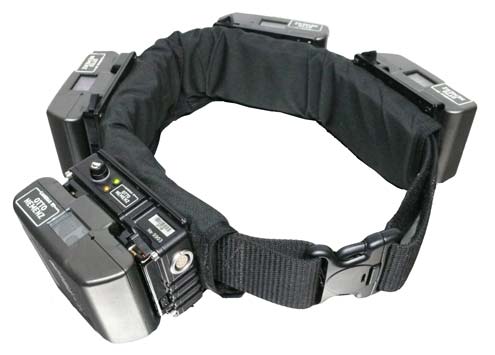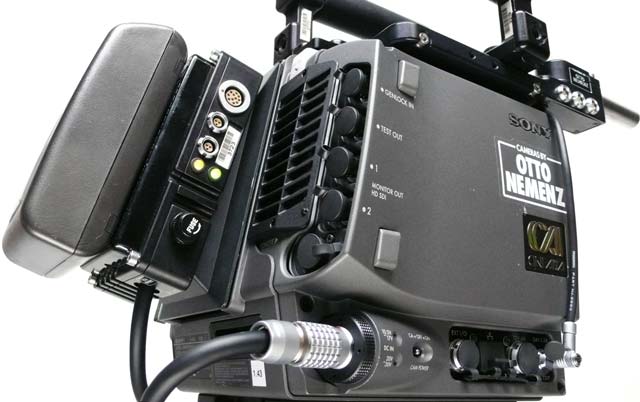Cinematographers and Rental Houses are afflicted with an obsession identified as “Retrofit Syndrome.” I don’t think there ever was a DP who didn’t immediately drill holes into a newly-purchased camera, and there certainly never was a camera that escaped Otto Nemenz’s or Denny Clairmont’s attention to detail and styling. “Retrofit Syndrome” was described by Bill Bennett, ASC, as “never being satisfied with what the manufacturer gives us–no matter how good.” So imagine the twitching of muscles and flexing of fingers upon arrival of new Sony F35 cameras into the machine shops of Otto Nemenz International recently. Like the wardrobe, make-up and hair stylists of the commercials and features these cameras serve, the mechanical and optical stylists at Nemenz have come up with highly innovative and helpful upgrades for all Sony F35 cameras they rent. With thanks to Ryan Sheridan for his pictures and explanations.
Mechanical:
A. Every Otto Nemenz camera comes with both a Low Profile Handle and 2 Low-Mode Cheese Plates to replace the stock Sony handles. They’ve added an ARRI-style RS 24 volt, 3-pin filtered power connector wired with ARRI RUN start/stop for the SRW-1 recorder.
B. Camera-mounted 15mm rod for lens motors mounted “Panavision-style” above and to the right of the lens provides easy conversion to and from Studio Mode, Handheld and Steadicam.
C. Multiple 1/4-20 and 3/8-16 holes for mounting accessories.
D. Pin-registered “Twist-Free” mounting points for heavy duty handles and Preston Wireless Receiver/Control Unit FIZ mounting plates.
 New 4-Axis Viewfinder Mounting System:
New 4-Axis Viewfinder Mounting System:
A. The Viewfinder moves in all directions to facilitate comfortable and natural handheld operation without camera operator neck strain.
B. Strong enough to operate with your free hand gripping the viewfinder.
C. Simple, one-piece finder extender adapter.
D. Finder extender and eyepiece can be “locked down” to work without a leveling rod attached to the head.
E. The eyepiece is removable, so the Sony Viewfinder can be used as a 2.3” monitor without additional hardware or change-over time.
F. Every camera comes with a camera-right side operating arm. The arm can swing the viewfinder over to the camera-right side for left eye, left shoulder operating or shooting in tight places. It can also be helpful for shooting with two cameras side by side. The arm can also be used as a modular extension eyepiece with no mechanical attachment to the camera (just a cable). This provides an almost unlimited range of eyepiece placement.
G. Modified viewfinder optics accommodate a greater range of diopter settings for all camera operators.
New 12 & 24 volt 360W battery belt system.
A. The battery belt powers a Sony F35 camera with SRW-1 deck, Preston FIZ, two On-Board Monitors, Cine tape and a wireless HD transmitter — all at the same time.
B. It can supply 12 & 24 volts from one Anton Bauer battery, with separate 12 and 24 volt power indicators on the belt. It has a field-replaceable fuse.
180W On-Board battery adapter:
A. Same features as the belt system, and: it mounts directly on the Otto Nemenz Low-Mode Utility plate (where the SRW-1 would dock at the back of the camera), without additional mounting plates or hardware.
B. Provides 12 and 24 volt power to the camera through the F35’s main power connector.
C. Provides additional 3-pin (RS connector) 24 volt and 11-pin Fischer 12 volt power distribution.
D. Provides balance on the back of the F35 when handheld.
E. Provides plenty of hot-swappable power for Steadicam use without drawing power from the sled.
And more:
The F35 PL lens mount has been realigned for consistent, precise fitting of long zoom lenses and attached matteboxes. There’s an AC & DC 2-camera engineering kit, lightweight fiber system that’s rugged enough to be run over by dollies and scissor lifts, and TrueLight OnSet color correction systems (to be discussed in a future article).
Ryan Sheridan writes about the new viewfinder system:
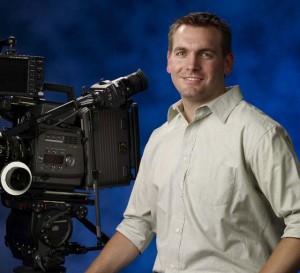
When you place an Arriflex 235 or 416 on your shoulder, the optical system meets your eye naturally. That’s not the case with current popular digital cinema cameras. Otto Nemenz insisted that his cameras be as comfortable as film cameras.
The picture of Geoff Boyle on page 35 of the 28th issue of FDTimes-online is the perfect illustration of why we redesigned the viewfinder system. We started by scrapping the original viewfinder mounting system. Then we researched ergonomic eye placement with the F35 on an operator’s shoulder. We looked at small operators, tall operators and even left-eye operators. After reviewing all the various eyepiece positions, we added our largest lenses and matteboxes into the equation.
Like a bespoke London tailor, we spent a week fitting and measuring to gather all the interference points and operational limitations of various lens, mattebox and filter tray combinations. Once we had all of that data, we could start working on the mechanics of the new viewfinder mounting system.
There was one more piece to the puzzle that we still had to take into account. Some operators like the original Sony eyepiece optics and some others like the optics of the Chrosziel viewfinder system. So, we had to make sure that whatever was designed worked equally well with both optical systems.
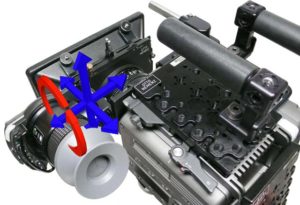
Otto’s last mandate was that the viewfinder had to be strong enough to grab with your left hand so you could use it like a handle when the camera is on your shoulder. I think Jon Fauer even warned against that on some film cameras–but this is strong enough.
With our new viewfinder system, I believe we hit all of our goals and requests. The system can accommodate a short prime lens and a clip-on mattebox without interfering with the comfortable operation of the viewfinder. You can grab it with your left hand and operate without breaking it off. It doesn’t require 6 extra pieces to add an eyepiece extender. A single mounting system accommodates two very different viewing systems. And, it is quick, comfortable, and easy to operate in any configuration.
Our cinematographers, operators and assistants have given us invaluable and field-tested feedback. We appreciate that kind of knowledge and experience, and look forward to continued cooperation in providing the best possible camera systems.

